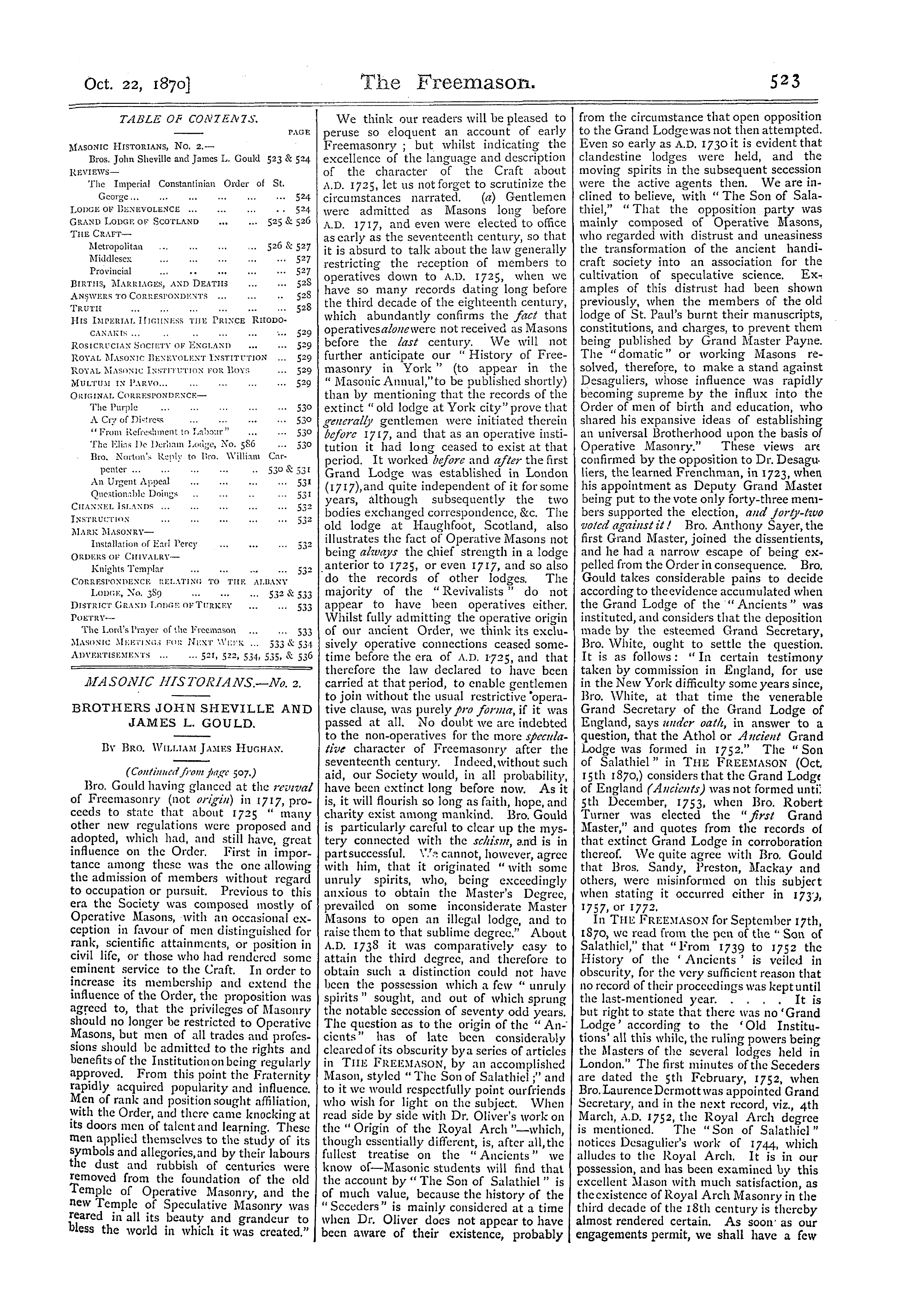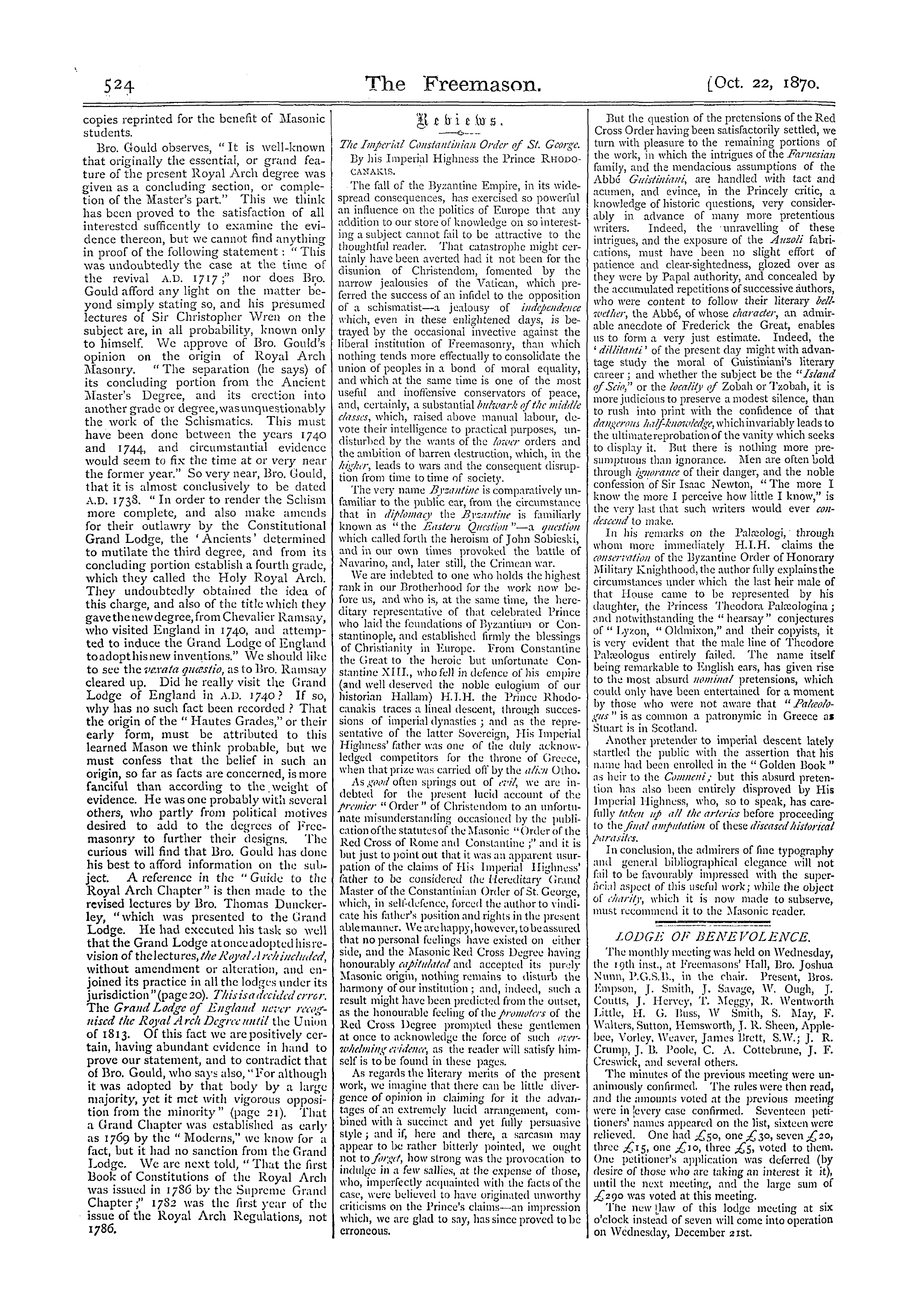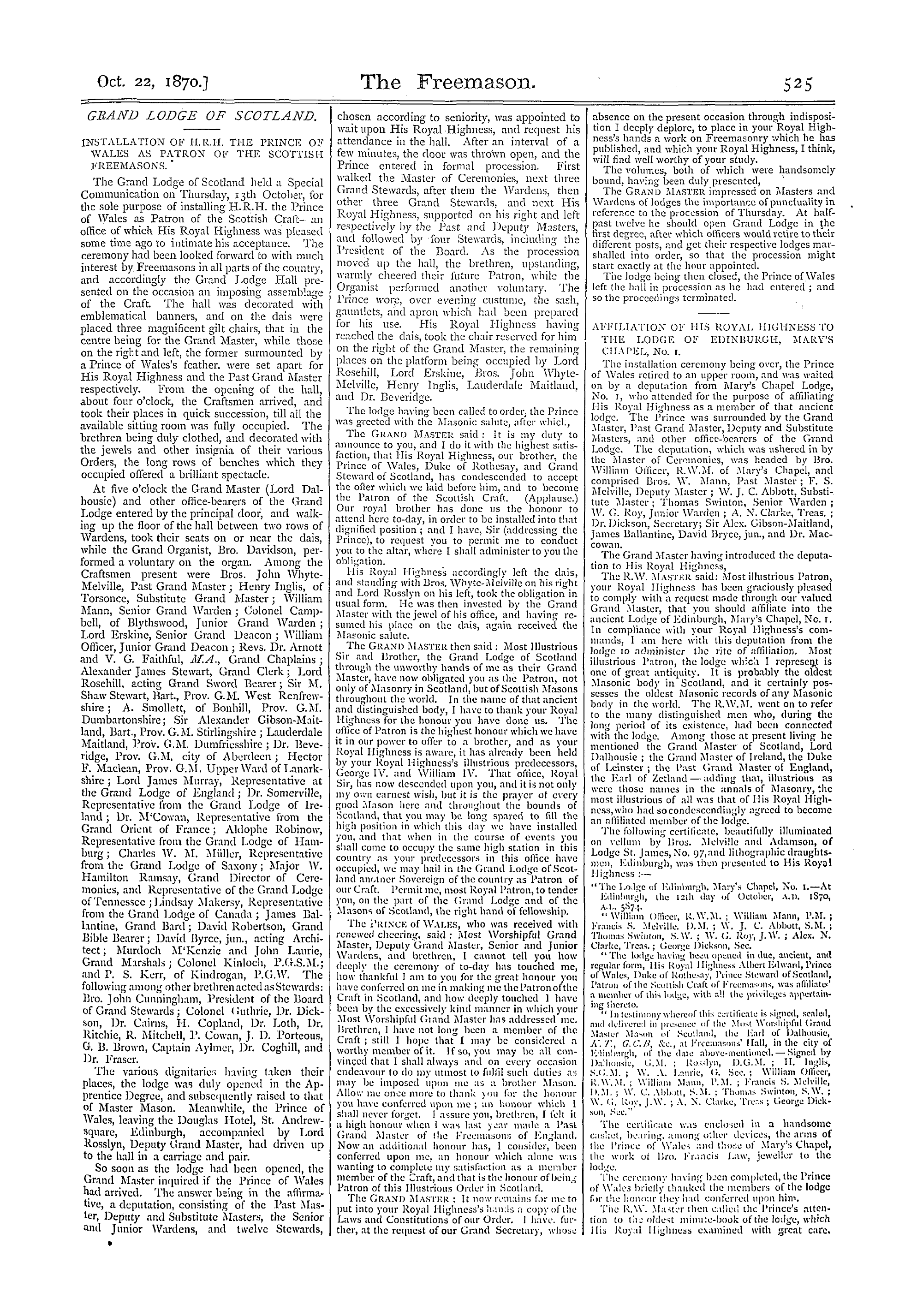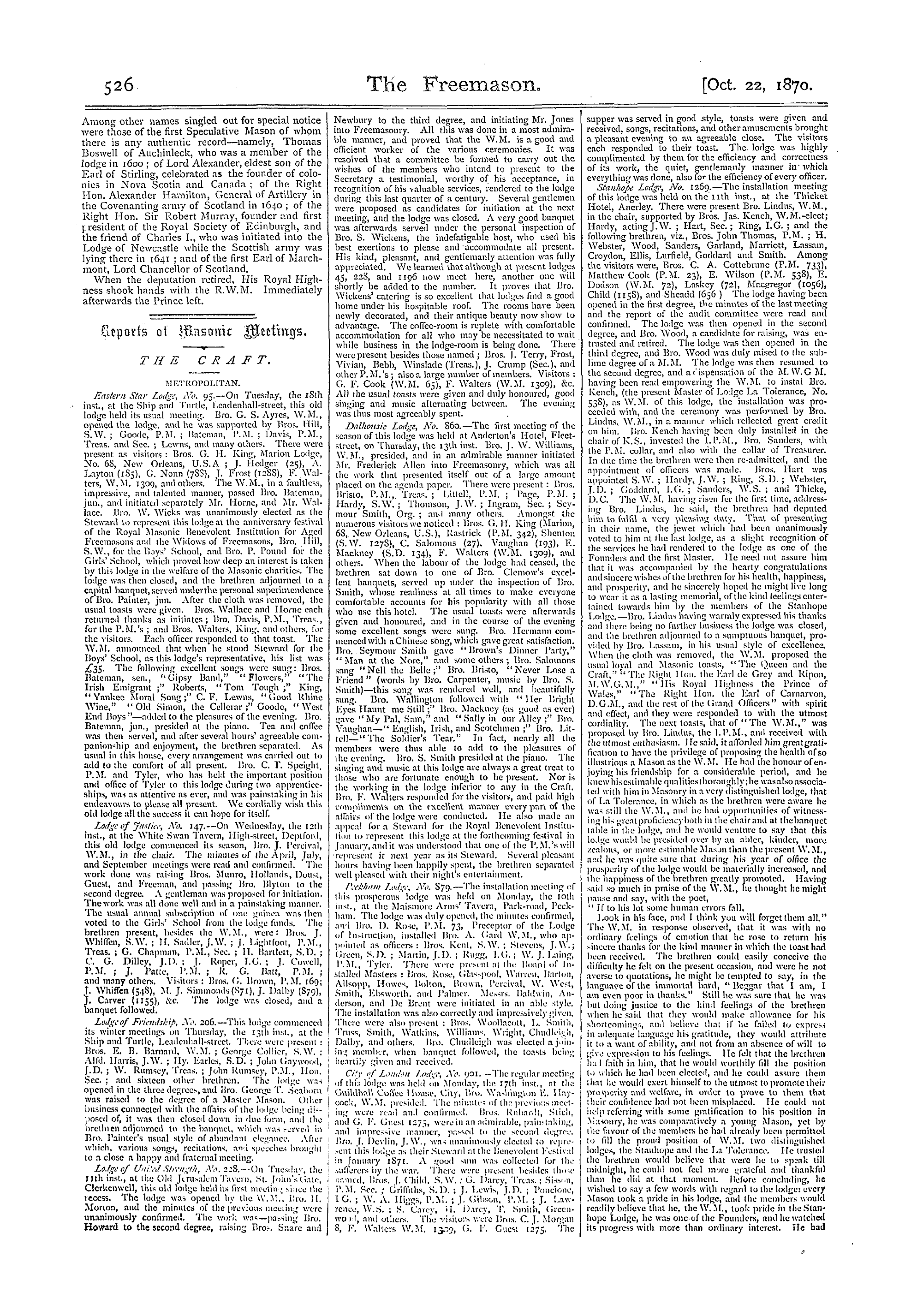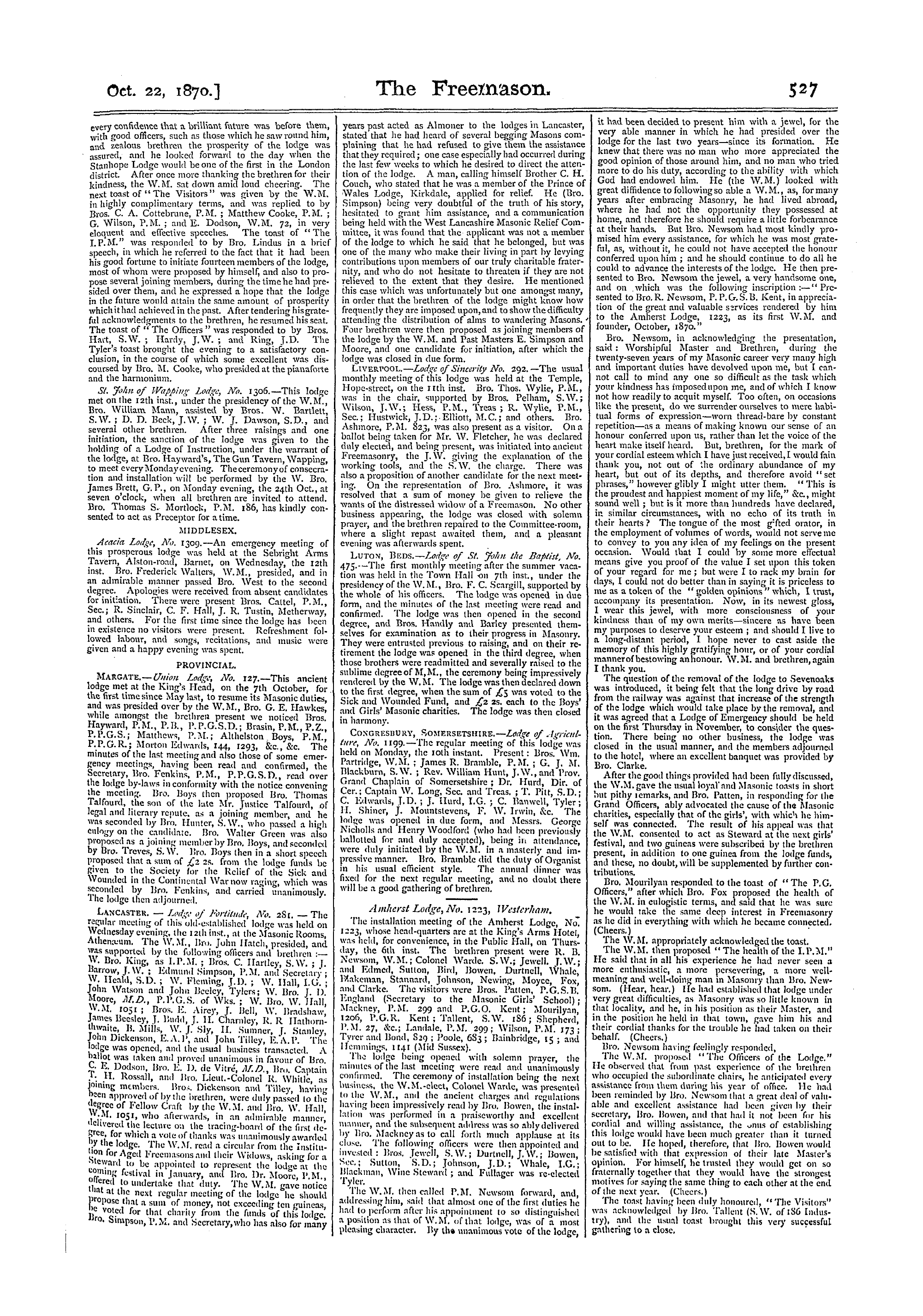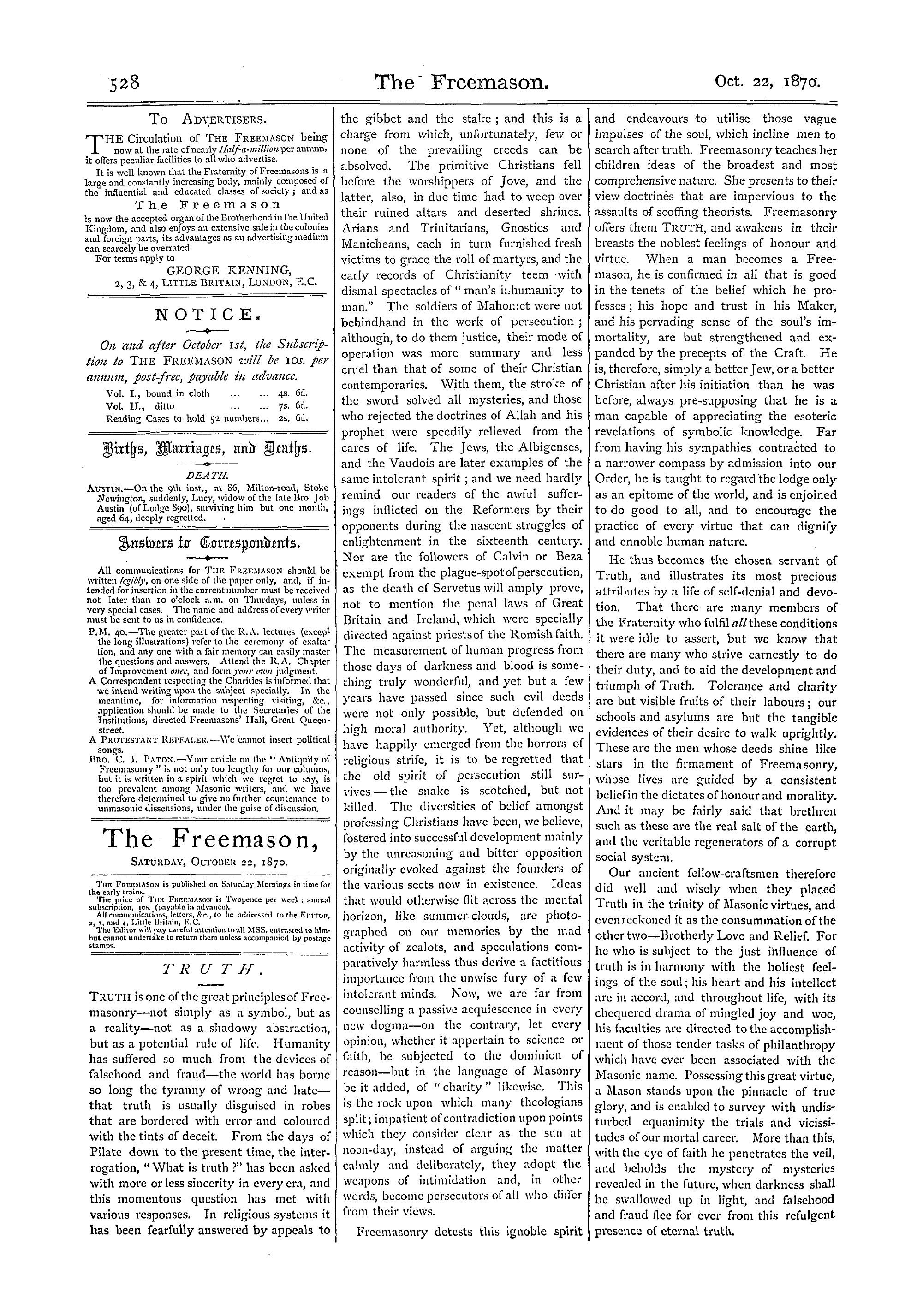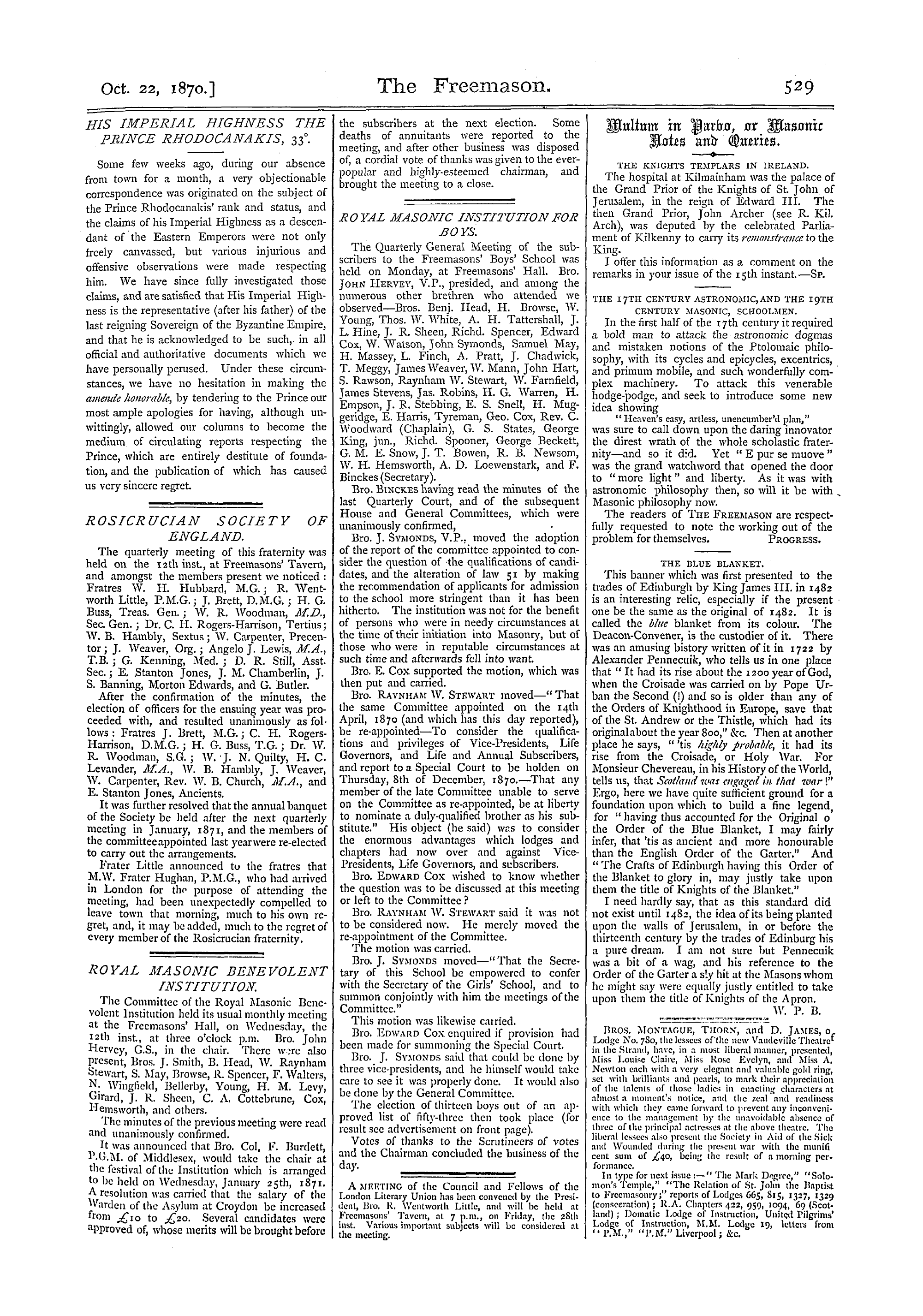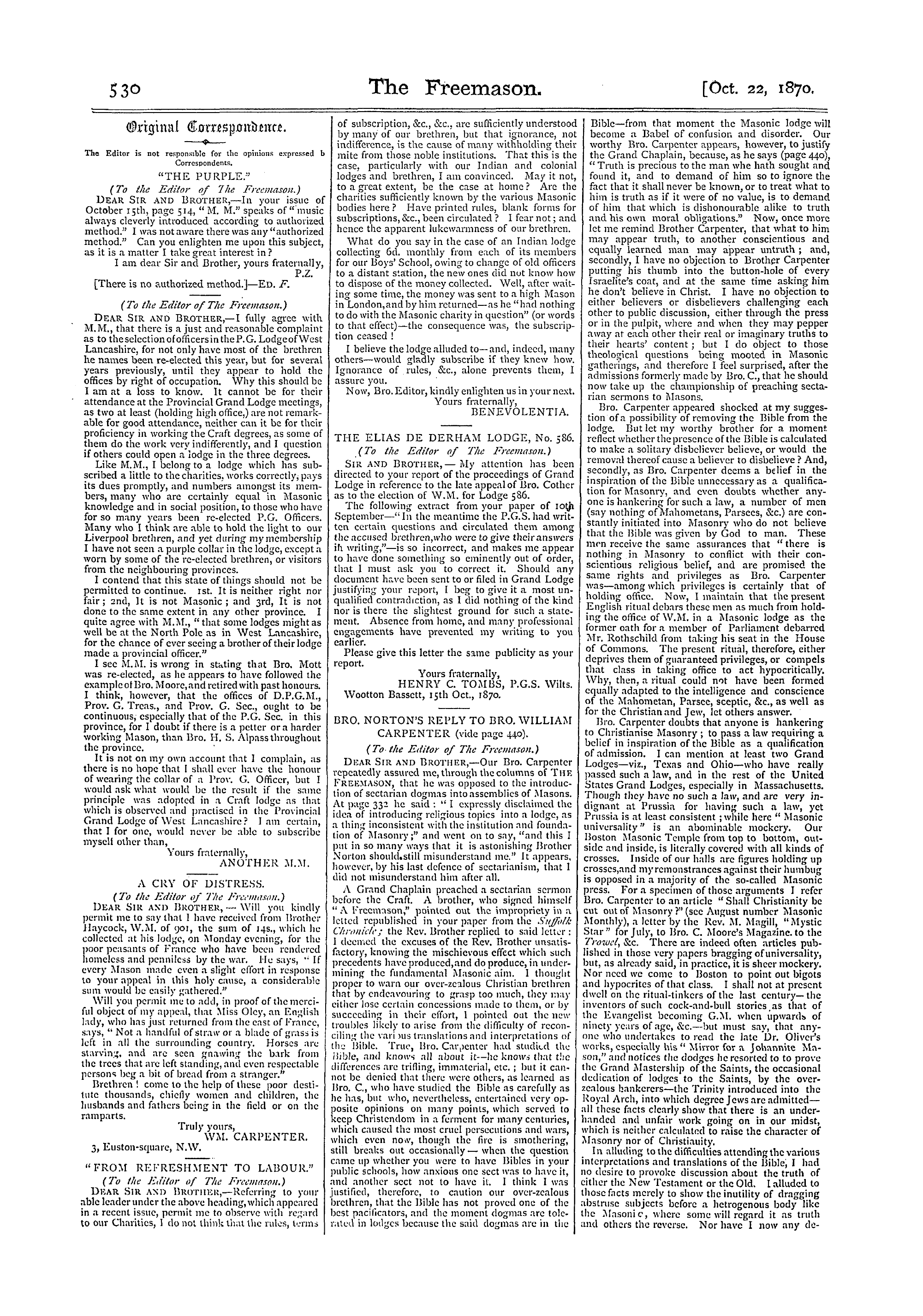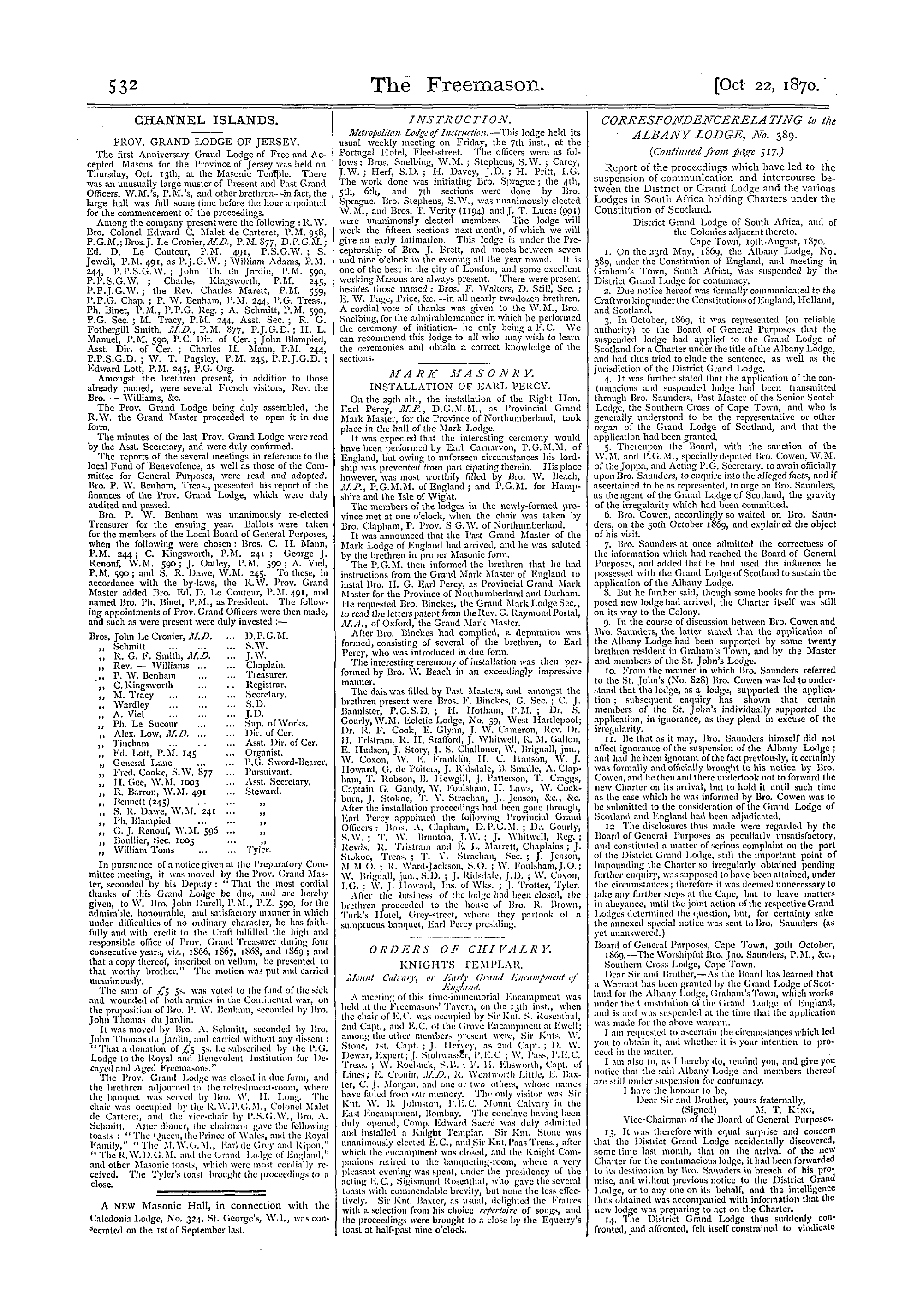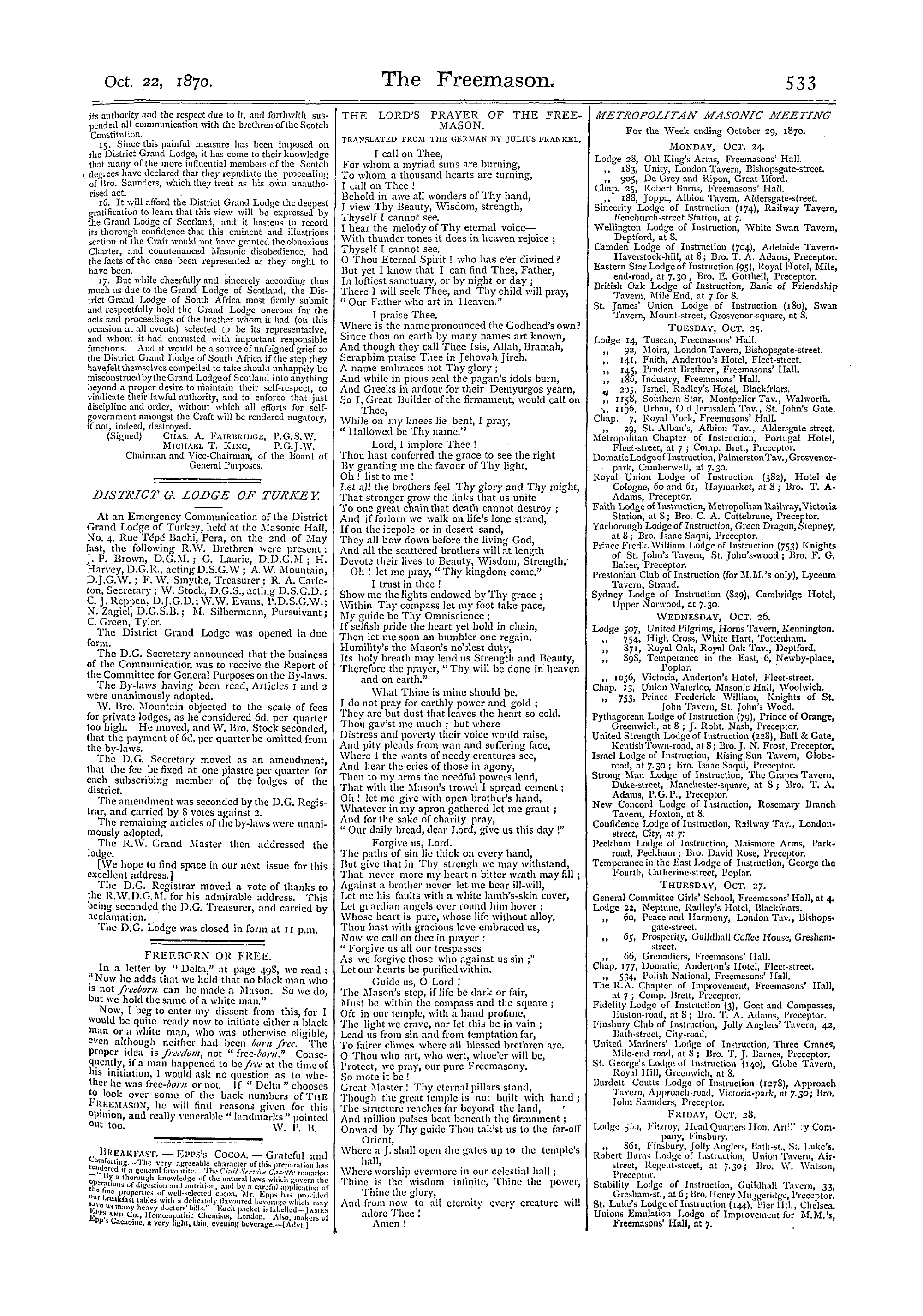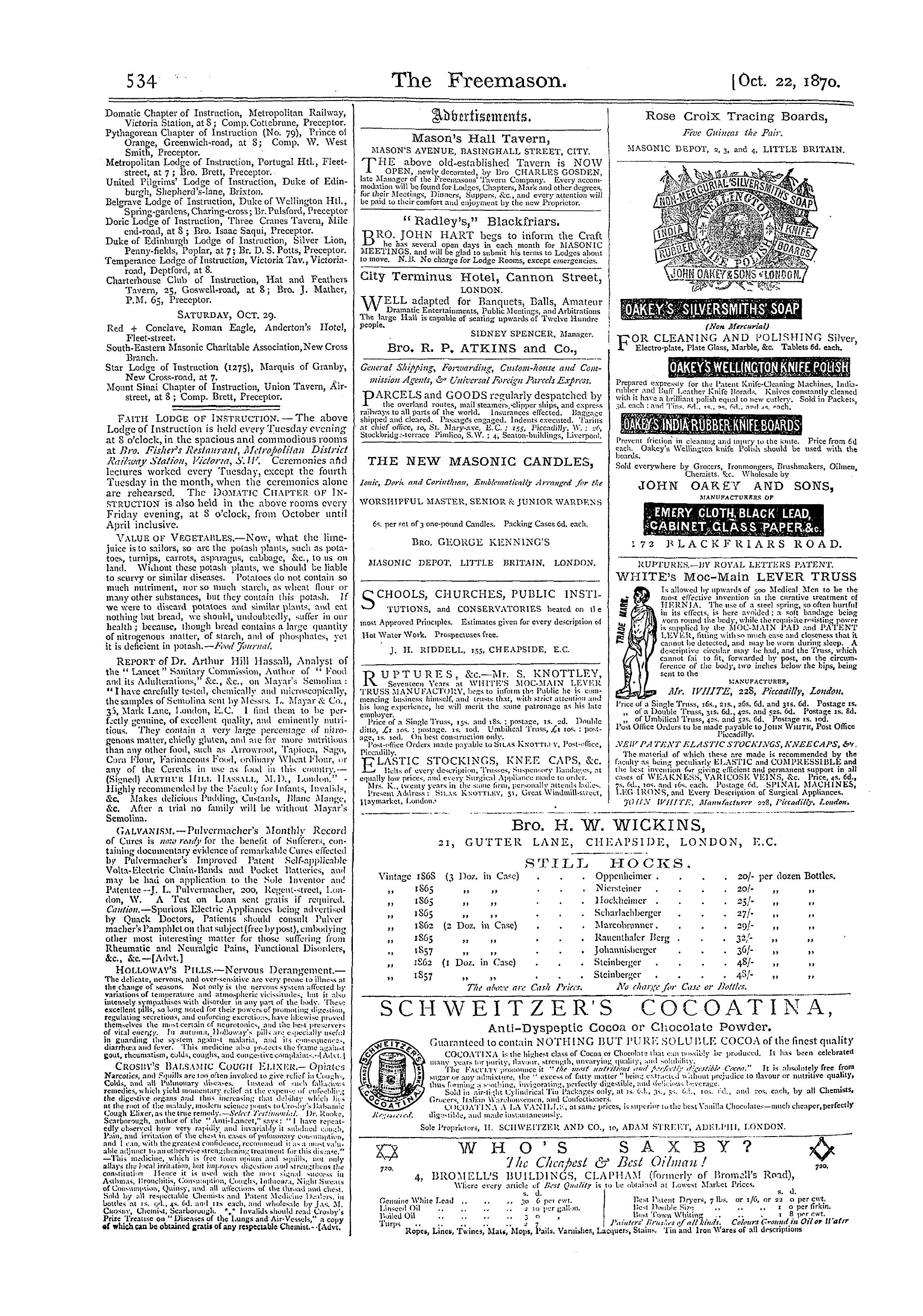-
Articles/Ads
Article TABLE OF CONTENTS. Page 1 of 1 Article BROTHERS JOHN SHEVILLE AND JAMES L. GOULD. Page 1 of 2 Article BROTHERS JOHN SHEVILLE AND JAMES L. GOULD. Page 1 of 2 Article BROTHERS JOHN SHEVILLE AND JAMES L. GOULD. Page 1 of 2 →
Note: This text has been automatically extracted via Optical Character Recognition (OCR) software.
Table Of Contents.
TABLE OF CONTENTS .
PAGB : M ASONIC HISTORIANS , NO . 2 . — Bros . John Sheville ancl James L . Gould 523 & 524 REVIEWSThe Imperial Constantinian Order of St .
George ... ... ... ... ... ... 5 4 L ODGE OF BENEVOLENCE 524 GRAND LODGE OF SCOTLAND 525 & 526 THE CRAFTMetropolitan 526 & 527
Middlesex 52 ? Provincial 5 7 BIRTHS , "MARRIAGES , AND DEATHS 52 S ANSWERS TO CORRESPONDENTS 528 TRUTH 528 His IMPERIAL HIGHNESS THE PRINCE R
IIODOCA . N ' AKIS ... 529 ROSICRL ' CIAN . SOCIETY OF ENGLAND 529 ROVAL MASONIC BENEVOLENT INSTITUTION ... 529 ROYAL M ASONIC INSTITUTION FOR BOYS ... 529 MULTUM IN PARVO 529
ORIGINAL C ORRESPONDENCEThe Purple 53 ° A Cry of Distress 53 ° "From Refreshment tn Labour" 530 The Elias Dc Derlinm Lodge , No . 586 ... 530 Bro . Norton ' s Rcnlv to Bro . William
Carpenter 530 & 531 An Urgent Appeal 531 Questionable Doings ... 531 CHANNEL ISLANDS 532 INSTRUCTION * 532 MARK
MASONRYInstallation of Earl Percy 532 ORDERS OF CHIVALRYKnights Templar ... ... ... ... 532 CORRESPONDENCE RELATING TO THE AI . UANY LODGE , No . 3 S 9 532 & 533
DISTRICT GRAND LODGE OF TURKEY 533 POETRYThe Lord's Prayer of thc Freemason ... ... 533 MASONIC MEETING . * '" HI : NEXT WEEK ... 533 & 534 ADVERTISEMENTS 521 , 522 , 534 , 535 , & 536
Brothers John Sheville And James L. Gould.
BROTHERS JOHN SHEVILLE AND JAMES L . GOULD .
MASONIC HISTORIANS . —No . 2 .
Bv BRO . WILLIAM J AMES HUGHAN ** . ( Continued from page $ oy . ) Bro . Gould having glanced at tlie revival of Freemasonry ( not origin ) in 1717 , proceeds to state that about 1725 " many
other new regulations were proposed and adopted , which had , and still have , great influence on the Order . First in importance among these was the one allowing the admission of members without regard
to occupation or pursuit . Previous to this era the Society was composed mostly of Operative Masons , with an occasional exception in favour of men distinguished for rank , scientific attainments , or position in civil life , or those who had rendered some
eminent service to the Craft . In order to increase its membership ancl extend the influence of the Order , the proposition was agreed to , that the privileges of Masonry should no longer be restricted to Operative
Masons , but men of all trades and professions should bc admitted to the rights and benefits of the Institutionon being regularly approved . From this point tlie Fraternity rapidly acquired popularity and influence .
Men of rank and position sought affiliation , with the Order , and there came knocking at its doors men of talent and learning . These men applied themselves to the study of its symbols and allegories , and by their labours
the dust and rubbish of centuries were Removed from the foundation of the old Temple of Operative Masonry , and the new Temple of Speculative Masonry was reared in all its beauty and grandeur to bless the world in which it was created . "
Brothers John Sheville And James L. Gould.
We think our readers will be pleased to peruse so eloquent an account of early Freemasonry ; but whilst indicating the excellence of the language and description of the character of the Craft about
A . D . 1725 , let us not forget to scrutinize the circumstances narrated . ( a ) Gentlemen were admitted as Masons long before A . D . 1717 , and even were elected to office as early as the seventeenth century , so that
it is absurd to talk about the law generally restricting the reception of members to operatives down to A . D . 1725 , when we have so many records dating long before the third decade of the eighteenth century ,
which abundantly confirms the fact that operatives «<* *
" Masonic Annual , " to be published shortly ) than by mentioning that the records of the extinct " old lodge at York city " prove that generally gentlemen were initiated therein before 1717 , and that as an operative institution it had loner ceased to exist at that
period . It worked before and after the first Grand Lodge was established in London ( 1717 ) , and quite independent of it for some years , although subsequently the two bodies exchanged correspondence , & c . The
old lodge at Haughfoot , Scotland , also illustrates the fact of Operative Masons not being always the chief strength in a lodge anterior to 1725 , or even 1717 , and so also do the records of other lodges . The
majority of the " Revivalists " do not appear to have been operatives either . Whilst fully admitting the operative origin of our ancient Order , we think its exclusively operative connections ceased
sometime before the era of A . D . 1725 , and that therefore the law declared to have been carried at that period , to enable gentlemen to join without the usual restrictive " operative clause , was purely pro forma , if it was
passed at all . No doubt we are indebted to the non-operatives for the more specula tive character of Freemasonry after the seventeenth century . Indeed , without such aid , our Society would , in all probability ,
have been extinct long before now . As it is , it will flourish so long as faith , hope , and charity exist among mankind . Bro . Gould is particularly careful to clear up the mystery connected with the schism , and is in
part successful . \ V « cannot , however , agree with him , that it originated " with some unruly spirits , who , being exceedingly anxious to obtain the Master ' s Degree , prevailed on some inconsiderate Master
Masons to open an illegal lodge , and to raise them to that sublime degree . " About A . D . 173 S it was comparatively easy to attain the third degree , and therefore to obtain such a distinction could not have
been the possession which a few " unruly spirits " sought , and out of which sprung the notable secession of seventy odd years . The question as to the origin of thc " Ancients" has of late been considerably
cleared of its obscurity by a series of articles in THE FREEMASON , by an accomplished Mason , styled " Thc Son of Salathiel ; " and to it we would respectfully point ourfriends
who wish for light on the subject . When read side by side with Dr . Oliver ' s work on the " Origin of the Royal Arch "—which , though essentially different , is , after all , the fullest treatise on the " Ancients" we
know of—Masonic students will find that the account by " The Son of Salathiel " is of much value , because the history of the "Seceders" is mainly considered at a time when Dr . Oliver does not appear to have been aware of their existence , probably
Brothers John Sheville And James L. Gould.
from the circumstance that open opposition to the Grand Lodge was not then attempted . Even so early as A . D . 1730 it is evident that clandestine lodges were held , and the moving spirits in the subsequent secession
were the active agents then . We are inclined to believe , with " The Son of Salathiel , " " That the opposition party was mainly composed of Operative Masons , who regarded with distrust and uneasiness the transformation of the ancient
handicraft society into an association for the cultivation of speculative science . Ex-: amples of this distrust had been shown previously , when the members of the old lodge of St . Paul ' s burnt their manuscripts ,
constitutions , and charges , to prevent them being published by Grand Master Payne . The "domatie" or working Masons resolved , therefore , to make a stand against Desaguliers , whose influence was rapidly
becoming supreme by the influx into the Order of men of birth and education , who shared his expansive ideas of establishing an universal Brotherhood upon the basis of Operative Masonry . " These views are
confirmed by the opposition to Dr . Desaguliers , the learned Frenchman , in 1723 , when his appointment as Deputy Grand Master being put to the vote only forty-three members supported the election , and forty-two
voted agamst it ! Bro . Anthony Sayer , the first Grand Master , joined the dissentients , and he had a narrow escape of being expelled from the Order in consequence . Bro . Gould takes considerable pains to decide
according to theevidence accumulated when the Grand Lodge of the " Ancients " was instituted , and considers that the deposition made by the esteemed Grand Secretary , Bro . White , ought to settle the question .
It is as follows : " In certain testimony taken by commission in England , for use in the New York difficulty some years since , Bro . White , at that time the venerable Grand Secretary of the Grand Lodge of
England , says under oath , in answer to a question , that the Athol or Ancient Grand Lodge was formed in 1752 . " The "Son of Salathiel " in THE FREEMASON ( Oct 15 th 1870 , ) considers that the Grand Lod g <
of England ( Ancients ) was not formed unti : 5 th December , 1753 , when Bro . Robert Turner was elected the "first Grand Master , " and quotes from the records of that extinct Grand Lodge in corroboration
thereof . We quite agree with Bro . Gould that Bros . Sandy , Preston , Mackay and others , were misinformed on this subject when stating it occurred either in 17 $ ) , 1757 , or 1772 .
In THE FREEMASON for September 17 th , 1 S 70 , wc read from the pen of the " Son of Salathiel , " that "From 1739 to 1752 the History of the ' Ancients ' is veiled in obscurity , for the very sufficient reason that
no record of their proceedings was kept until the last-mentioned year . .... It is but right to state that there was no 'Grand Lodge' according to the 'Old Institutions' all this while , the ruling powers being
the Masters of thc several lodges held in London . " The first minutes of the Seceders are dated the 5 th February , 1752 , when Bro . Laurence Dermott was appointed Grand Secretary , and in the next record , viz ., 4 th
March , A . D . 1752 , the Royal Arch degree is mentioned . The " Son of Salathiel " notices Desagulier ' s work of 1744 , which alludes to the Royal Arch . It is in our possession , and has been examined by this
excellent Mason with much satisfaction , as theexistence of Royal Arch Masonry in the third decade ofthe 18 th century is thereby almost rendered certain . As soon * as our engagements permit , we shall have a few
Note: This text has been automatically extracted via Optical Character Recognition (OCR) software.
Table Of Contents.
TABLE OF CONTENTS .
PAGB : M ASONIC HISTORIANS , NO . 2 . — Bros . John Sheville ancl James L . Gould 523 & 524 REVIEWSThe Imperial Constantinian Order of St .
George ... ... ... ... ... ... 5 4 L ODGE OF BENEVOLENCE 524 GRAND LODGE OF SCOTLAND 525 & 526 THE CRAFTMetropolitan 526 & 527
Middlesex 52 ? Provincial 5 7 BIRTHS , "MARRIAGES , AND DEATHS 52 S ANSWERS TO CORRESPONDENTS 528 TRUTH 528 His IMPERIAL HIGHNESS THE PRINCE R
IIODOCA . N ' AKIS ... 529 ROSICRL ' CIAN . SOCIETY OF ENGLAND 529 ROVAL MASONIC BENEVOLENT INSTITUTION ... 529 ROYAL M ASONIC INSTITUTION FOR BOYS ... 529 MULTUM IN PARVO 529
ORIGINAL C ORRESPONDENCEThe Purple 53 ° A Cry of Distress 53 ° "From Refreshment tn Labour" 530 The Elias Dc Derlinm Lodge , No . 586 ... 530 Bro . Norton ' s Rcnlv to Bro . William
Carpenter 530 & 531 An Urgent Appeal 531 Questionable Doings ... 531 CHANNEL ISLANDS 532 INSTRUCTION * 532 MARK
MASONRYInstallation of Earl Percy 532 ORDERS OF CHIVALRYKnights Templar ... ... ... ... 532 CORRESPONDENCE RELATING TO THE AI . UANY LODGE , No . 3 S 9 532 & 533
DISTRICT GRAND LODGE OF TURKEY 533 POETRYThe Lord's Prayer of thc Freemason ... ... 533 MASONIC MEETING . * '" HI : NEXT WEEK ... 533 & 534 ADVERTISEMENTS 521 , 522 , 534 , 535 , & 536
Brothers John Sheville And James L. Gould.
BROTHERS JOHN SHEVILLE AND JAMES L . GOULD .
MASONIC HISTORIANS . —No . 2 .
Bv BRO . WILLIAM J AMES HUGHAN ** . ( Continued from page $ oy . ) Bro . Gould having glanced at tlie revival of Freemasonry ( not origin ) in 1717 , proceeds to state that about 1725 " many
other new regulations were proposed and adopted , which had , and still have , great influence on the Order . First in importance among these was the one allowing the admission of members without regard
to occupation or pursuit . Previous to this era the Society was composed mostly of Operative Masons , with an occasional exception in favour of men distinguished for rank , scientific attainments , or position in civil life , or those who had rendered some
eminent service to the Craft . In order to increase its membership ancl extend the influence of the Order , the proposition was agreed to , that the privileges of Masonry should no longer be restricted to Operative
Masons , but men of all trades and professions should bc admitted to the rights and benefits of the Institutionon being regularly approved . From this point tlie Fraternity rapidly acquired popularity and influence .
Men of rank and position sought affiliation , with the Order , and there came knocking at its doors men of talent and learning . These men applied themselves to the study of its symbols and allegories , and by their labours
the dust and rubbish of centuries were Removed from the foundation of the old Temple of Operative Masonry , and the new Temple of Speculative Masonry was reared in all its beauty and grandeur to bless the world in which it was created . "
Brothers John Sheville And James L. Gould.
We think our readers will be pleased to peruse so eloquent an account of early Freemasonry ; but whilst indicating the excellence of the language and description of the character of the Craft about
A . D . 1725 , let us not forget to scrutinize the circumstances narrated . ( a ) Gentlemen were admitted as Masons long before A . D . 1717 , and even were elected to office as early as the seventeenth century , so that
it is absurd to talk about the law generally restricting the reception of members to operatives down to A . D . 1725 , when we have so many records dating long before the third decade of the eighteenth century ,
which abundantly confirms the fact that operatives «<* *
" Masonic Annual , " to be published shortly ) than by mentioning that the records of the extinct " old lodge at York city " prove that generally gentlemen were initiated therein before 1717 , and that as an operative institution it had loner ceased to exist at that
period . It worked before and after the first Grand Lodge was established in London ( 1717 ) , and quite independent of it for some years , although subsequently the two bodies exchanged correspondence , & c . The
old lodge at Haughfoot , Scotland , also illustrates the fact of Operative Masons not being always the chief strength in a lodge anterior to 1725 , or even 1717 , and so also do the records of other lodges . The
majority of the " Revivalists " do not appear to have been operatives either . Whilst fully admitting the operative origin of our ancient Order , we think its exclusively operative connections ceased
sometime before the era of A . D . 1725 , and that therefore the law declared to have been carried at that period , to enable gentlemen to join without the usual restrictive " operative clause , was purely pro forma , if it was
passed at all . No doubt we are indebted to the non-operatives for the more specula tive character of Freemasonry after the seventeenth century . Indeed , without such aid , our Society would , in all probability ,
have been extinct long before now . As it is , it will flourish so long as faith , hope , and charity exist among mankind . Bro . Gould is particularly careful to clear up the mystery connected with the schism , and is in
part successful . \ V « cannot , however , agree with him , that it originated " with some unruly spirits , who , being exceedingly anxious to obtain the Master ' s Degree , prevailed on some inconsiderate Master
Masons to open an illegal lodge , and to raise them to that sublime degree . " About A . D . 173 S it was comparatively easy to attain the third degree , and therefore to obtain such a distinction could not have
been the possession which a few " unruly spirits " sought , and out of which sprung the notable secession of seventy odd years . The question as to the origin of thc " Ancients" has of late been considerably
cleared of its obscurity by a series of articles in THE FREEMASON , by an accomplished Mason , styled " Thc Son of Salathiel ; " and to it we would respectfully point ourfriends
who wish for light on the subject . When read side by side with Dr . Oliver ' s work on the " Origin of the Royal Arch "—which , though essentially different , is , after all , the fullest treatise on the " Ancients" we
know of—Masonic students will find that the account by " The Son of Salathiel " is of much value , because the history of the "Seceders" is mainly considered at a time when Dr . Oliver does not appear to have been aware of their existence , probably
Brothers John Sheville And James L. Gould.
from the circumstance that open opposition to the Grand Lodge was not then attempted . Even so early as A . D . 1730 it is evident that clandestine lodges were held , and the moving spirits in the subsequent secession
were the active agents then . We are inclined to believe , with " The Son of Salathiel , " " That the opposition party was mainly composed of Operative Masons , who regarded with distrust and uneasiness the transformation of the ancient
handicraft society into an association for the cultivation of speculative science . Ex-: amples of this distrust had been shown previously , when the members of the old lodge of St . Paul ' s burnt their manuscripts ,
constitutions , and charges , to prevent them being published by Grand Master Payne . The "domatie" or working Masons resolved , therefore , to make a stand against Desaguliers , whose influence was rapidly
becoming supreme by the influx into the Order of men of birth and education , who shared his expansive ideas of establishing an universal Brotherhood upon the basis of Operative Masonry . " These views are
confirmed by the opposition to Dr . Desaguliers , the learned Frenchman , in 1723 , when his appointment as Deputy Grand Master being put to the vote only forty-three members supported the election , and forty-two
voted agamst it ! Bro . Anthony Sayer , the first Grand Master , joined the dissentients , and he had a narrow escape of being expelled from the Order in consequence . Bro . Gould takes considerable pains to decide
according to theevidence accumulated when the Grand Lodge of the " Ancients " was instituted , and considers that the deposition made by the esteemed Grand Secretary , Bro . White , ought to settle the question .
It is as follows : " In certain testimony taken by commission in England , for use in the New York difficulty some years since , Bro . White , at that time the venerable Grand Secretary of the Grand Lodge of
England , says under oath , in answer to a question , that the Athol or Ancient Grand Lodge was formed in 1752 . " The "Son of Salathiel " in THE FREEMASON ( Oct 15 th 1870 , ) considers that the Grand Lod g <
of England ( Ancients ) was not formed unti : 5 th December , 1753 , when Bro . Robert Turner was elected the "first Grand Master , " and quotes from the records of that extinct Grand Lodge in corroboration
thereof . We quite agree with Bro . Gould that Bros . Sandy , Preston , Mackay and others , were misinformed on this subject when stating it occurred either in 17 $ ) , 1757 , or 1772 .
In THE FREEMASON for September 17 th , 1 S 70 , wc read from the pen of the " Son of Salathiel , " that "From 1739 to 1752 the History of the ' Ancients ' is veiled in obscurity , for the very sufficient reason that
no record of their proceedings was kept until the last-mentioned year . .... It is but right to state that there was no 'Grand Lodge' according to the 'Old Institutions' all this while , the ruling powers being
the Masters of thc several lodges held in London . " The first minutes of the Seceders are dated the 5 th February , 1752 , when Bro . Laurence Dermott was appointed Grand Secretary , and in the next record , viz ., 4 th
March , A . D . 1752 , the Royal Arch degree is mentioned . The " Son of Salathiel " notices Desagulier ' s work of 1744 , which alludes to the Royal Arch . It is in our possession , and has been examined by this
excellent Mason with much satisfaction , as theexistence of Royal Arch Masonry in the third decade ofthe 18 th century is thereby almost rendered certain . As soon * as our engagements permit , we shall have a few
